Have you ever noticed how everyone on safari sports a certain look? Clothes are light and breezy, colours tend to come in varying shades of beige and green, and layers are an absolute must.
Before going on safari in Kruger National Park, I thought this was purely for fashion’s sake, however, it turns out there’s a good reason for dressing this way. Bright colours are to be avoided because they attract animals plus they can be distracting for safari goers looking to spot wildlife, black and dark blue can attract tsetse flies (usually an issue in mid-continental Africa between the Sahara and the Kalahari Deserts), and white is usually a no go because dirt shows very easily. So what are you left with? Beige, green, and some natural earth tones.
In this post I’ll be sharing what to wear on safari complete with a packing list. Keep in mind that I did my safari in South Africa in autumn, so you’ll want to double check the temperatures according to where and when you’re going.
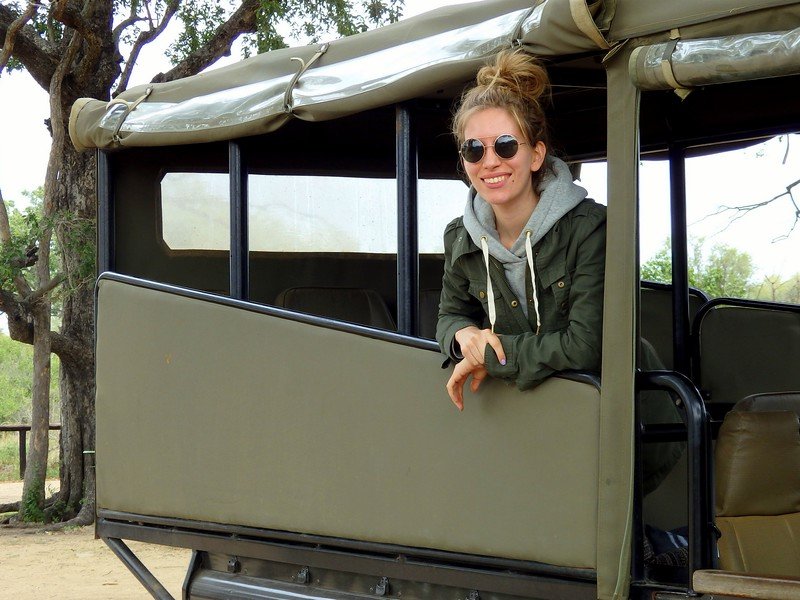
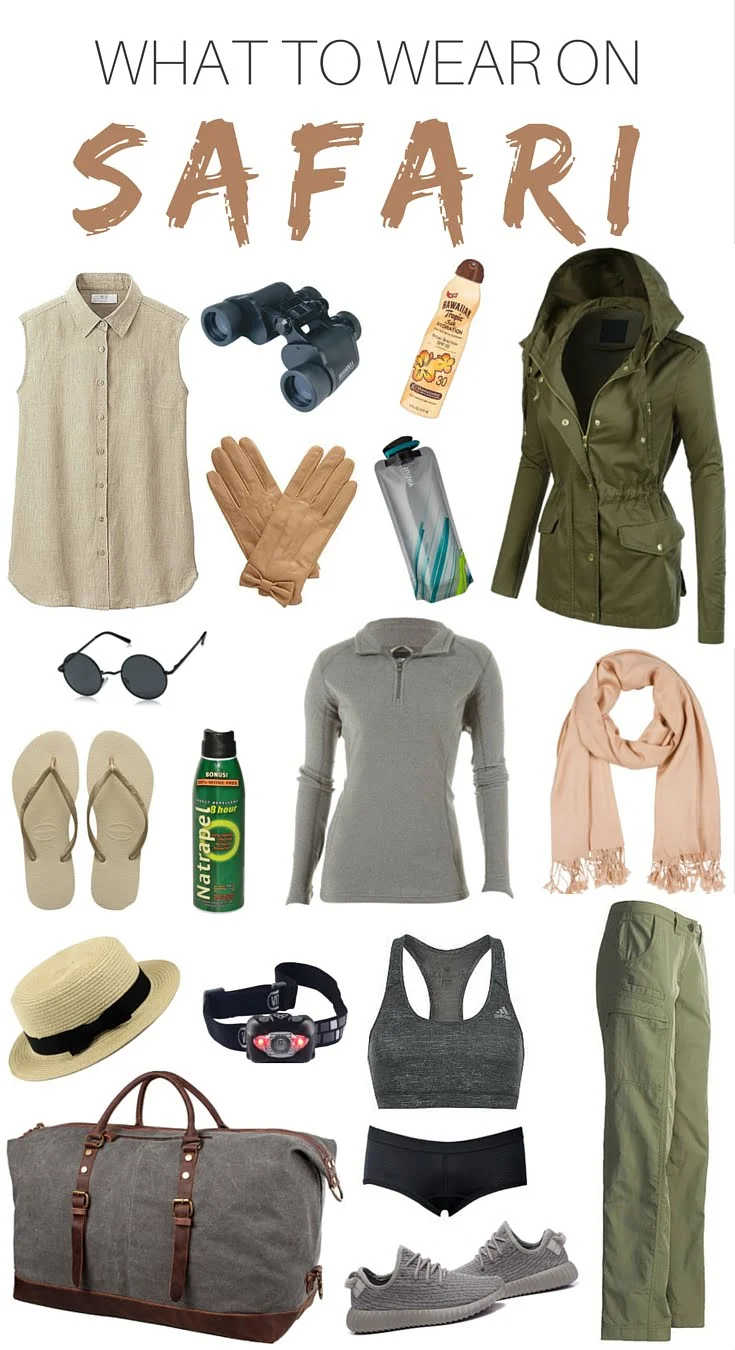
What to Wear on Safari in Kruger National Park
Shirts:
You’ll want light breathable fabrics in neutral tones. I packed a mix of short sleeve and capped sleeve shirts.
Pants:
I mostly wore leggings on safari. I had one pair of cotton leggings that I pretty much wore nonstop and another pair of wool leggings that I wore overtop in the mornings until the day warmed up. If you’re not really into leggings, you could consider convertible pants to shorts to get you through the drastic change in temperature.
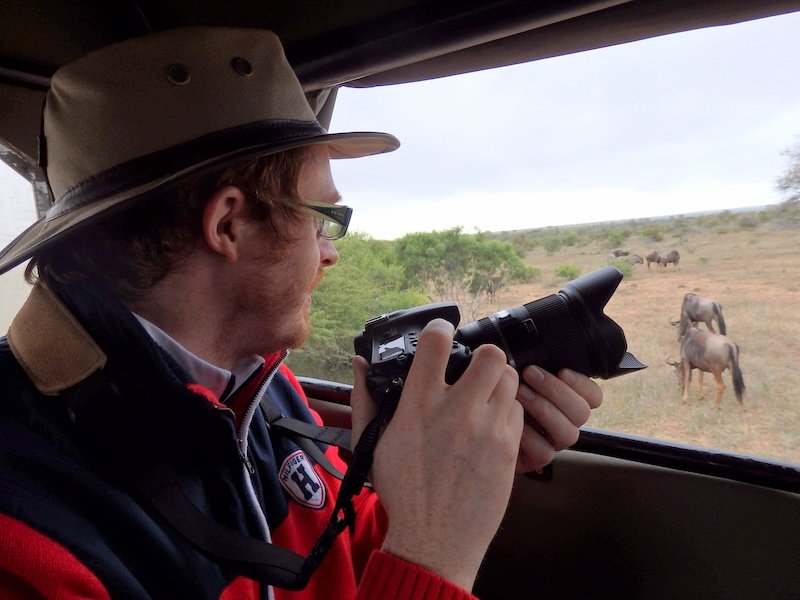
Fleece or warm hoodie:
A fleece or a thick hoodie is an absolute must. If you visiting Kruger National Park during the cooler months like I did, you’ll be seeing average highs around 25°C and lows that barely hover above 0°C. Now imagine driving in an open game viewing vehicle in the early morning with the wind whipping you in the face – that’s cold! Your safari operator will likely provide you with wool blankets to wrap yourself in, but you’ll want to be wearing all your warmest layers.
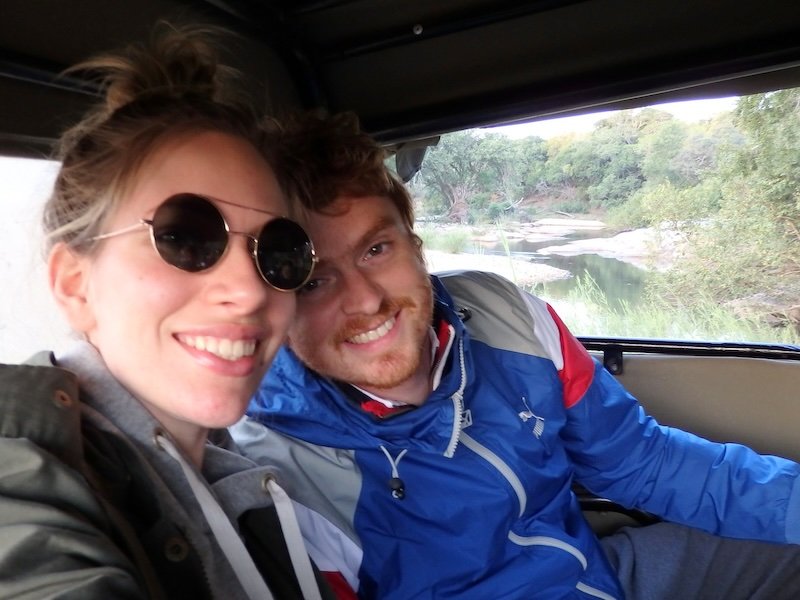
Jacket:
Aside from a fleece, it’s also a good idea to bring a jacket. This gives you an added layer of warmth, or you can wear it over your shirt once it’s too hot for your fleece.
Scarf:
I brought a light pashmina mostly to wear in the mornings and evenings.
Gloves:
I know this probably sounds extreme, but if you’re visiting during the winter months you’ll be glad you brought a pair of gloves or mittens. They don’t have to be thick; just something light to wear when it’s cold.
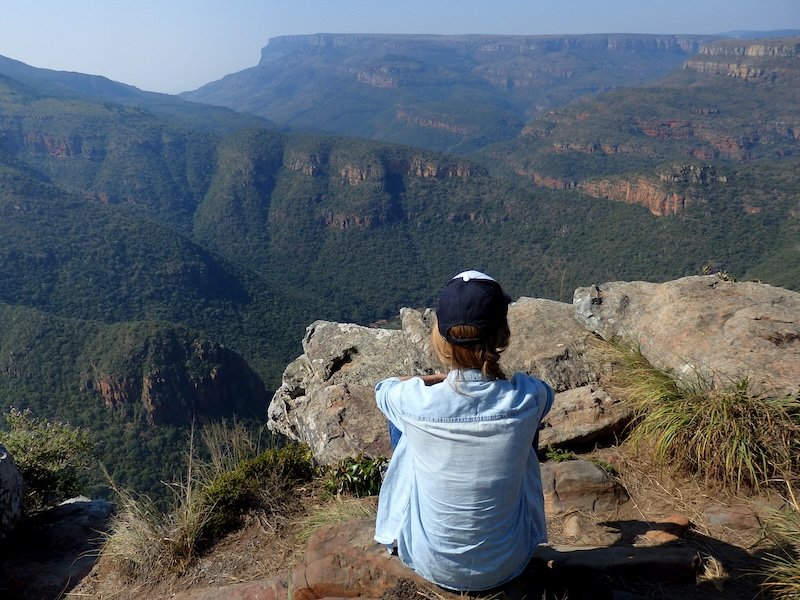
Hat:
The sun can get quite strong during the day, so be sure to pack a hat, especially if you’re going to be doing some walking safaris. Something with a wide brim would be best so that you can get protection on the back of your neck.
Underwear and sports bra:
Safari drives can be bumpy, so girls, choose something that works for you. As for underwear, a good option is the ExOfficio route which are quick-drying, odour resistant, and breathable.
Sneakers:
A pair of sneakers or running shoes is perfectly fine. Unless you’re planning on doing a long walking safari, there is no need for heavy hiking shoes.
Socks:
I’d go for a crew sock that covers your ankles, because again, I was cold.
Flip Flops:
Flip flops are great to wear around camp in the afternoons or for the shower.
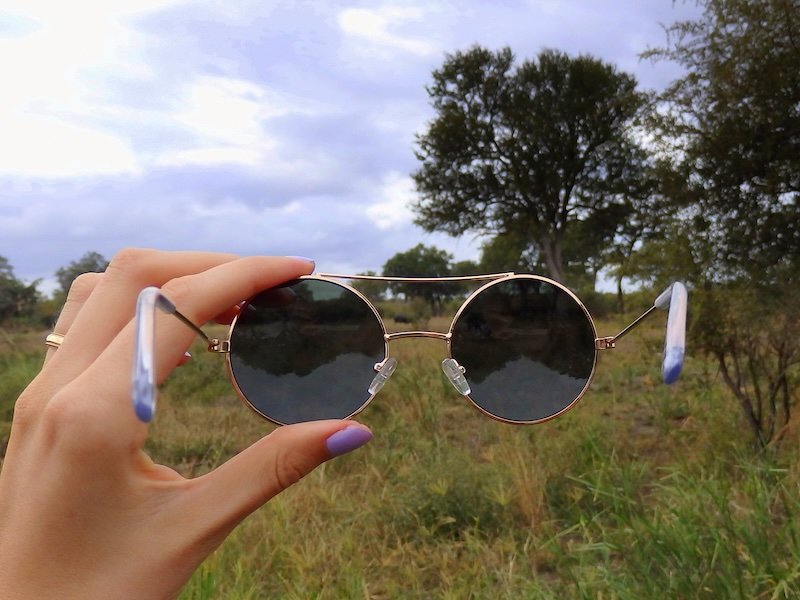
Sunglasses:
I found a fun pair of Lennon sunglasses (similar here), but anything that’s going to keep the sun out of your eyes is fine.
Sunscreen:
Safari days are along. Bring some SPF so you don’t end up with a bad sunburn.
Insect repellant:
Mosquitoes were not an issue when I visited in winter, however, you may want to bring some repellent if you’re doing your safari during the warmer months.
Flashlight or headlamp:
Packing a flashlight or a headlamp is especially important if you’re doing a camping safari that involves a bit of a trek from your tent to the bathroom. Even though we ended up upgrading to a cottage (with electricity!), we still used it to get around the campsite and when we went out on a nighttime safari.
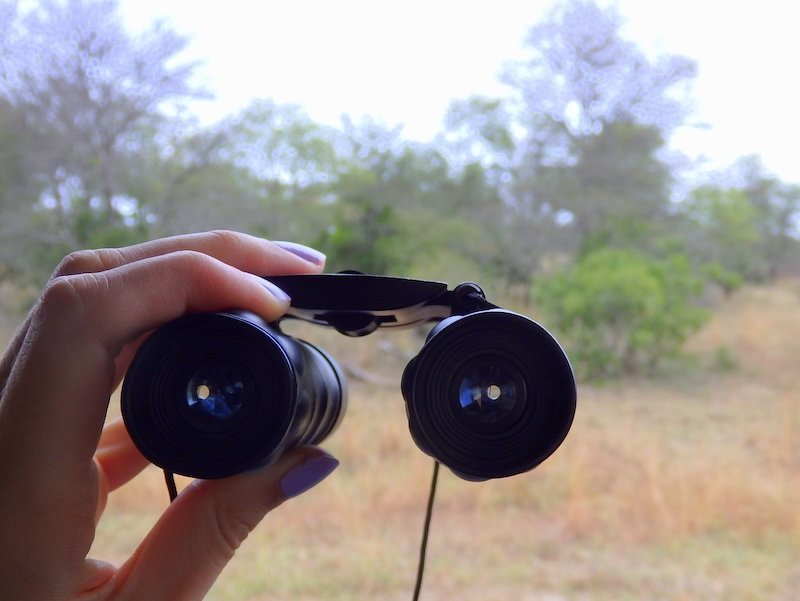
Binoculars:
If you’re an avid wildlife spotter, you may want to consider packing a set of binoculars to look at smaller animals or those that are further away. We had one set of binoculars to share in our vehicle, which was fine.
Water bottle and snacks:
It’s also a good idea to bring a refillable water bottle as well as some snacks since safari outings can be quite long.
Weekender bag:
Depending on the length of your safari, you may want to bring along a weekender bag as opposed to hauling along all of your luggage. Most hotels and safari operators will hold your luggage for you, especially if you’re only planning to be away a few days.
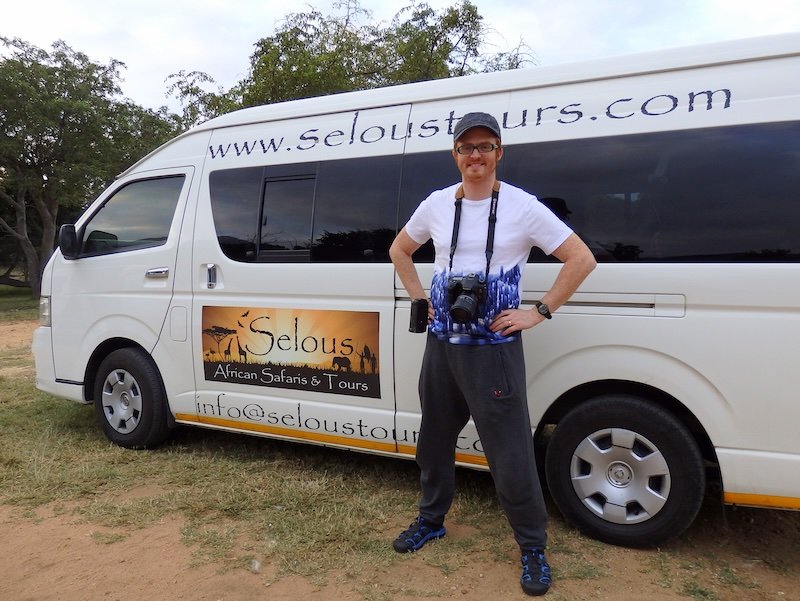
Beyond the Basics: Outfit Planning, Smart Packing & Real-World Safari Tips
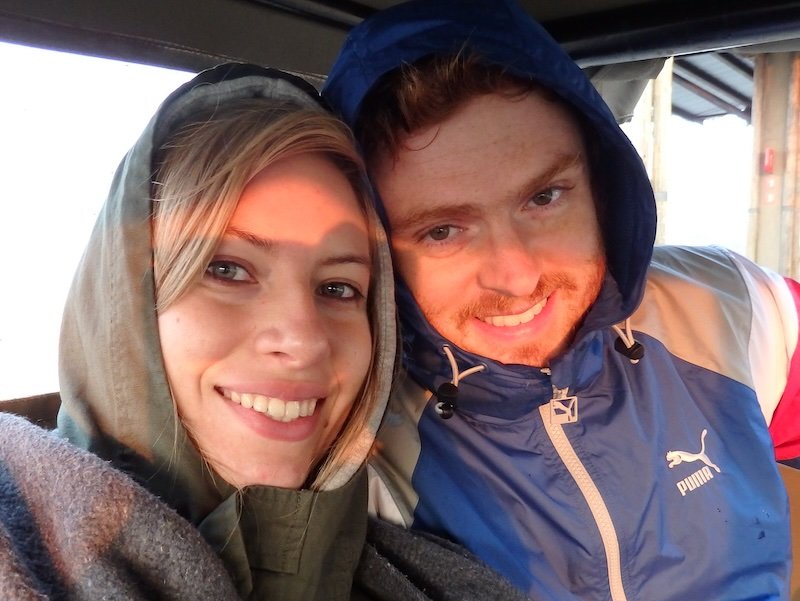
How to Dress for Different Safari Seasons & Regions
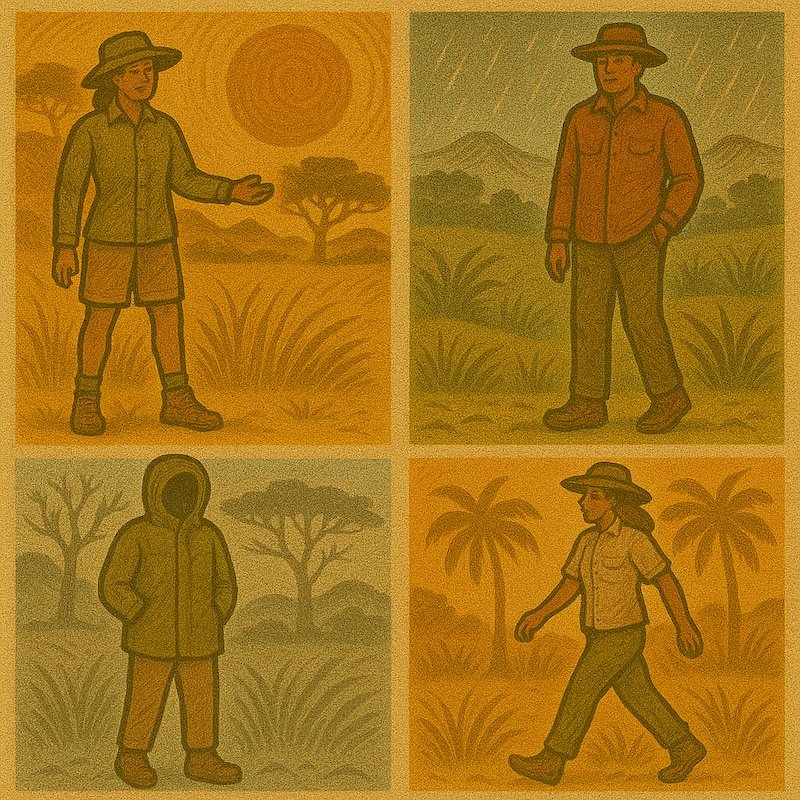
Safaris swing from shivery sunrise to toasty lunchtime within a few hours. Your clothing has to flex with the weather and the wind of open vehicles.
Southern Africa (Kruger, Kgalagadi, Chobe)
- Winter (Jun–Aug): Cold, dry mornings; crisp sunny days.
Wear: thermal or wool base layer + long-sleeve tee + fleece + light windproof shell at dawn; peel down to tee and light scarf by late morning. Add beanie and light gloves if you feel the cold (I did!). - Shoulder (Apr–May, Sep–Oct): Cool mornings, warm afternoons, dust.
Wear: breathable long sleeves you can roll up, convertible pants, buff for dust, and sunglasses you won’t mind wiping constantly. - Summer (Nov–Mar): Hot, sometimes stormy.
Wear: airy long-sleeve UPF shirt, quick-dry pants/shorts, wide-brim hat. Pack a light rain shell for surprise downpours.
East Africa (Serengeti, Maasai Mara, Amboseli)
- Dry season (Jun–Oct): Cooler at elevation (Ngorongoro can be chilly), very dusty.
Wear: same layers as winter above plus a warmer mid-layer for crater rim mornings. - Green season (Nov–Dec & Mar–May): Warm, humid, brief showers.
Wear: quick-dry fabrics, light rain jacket, anti-chafe shorts under looser pants/skirts.
Desert & Dunes (Namib, Skeleton Coast)
- Year-round big swings (cold foggy mornings; blazing sun later).
Wear: windproof layer, neck gaiter for sand, sunglasses that seal well, lip balm with SPF.
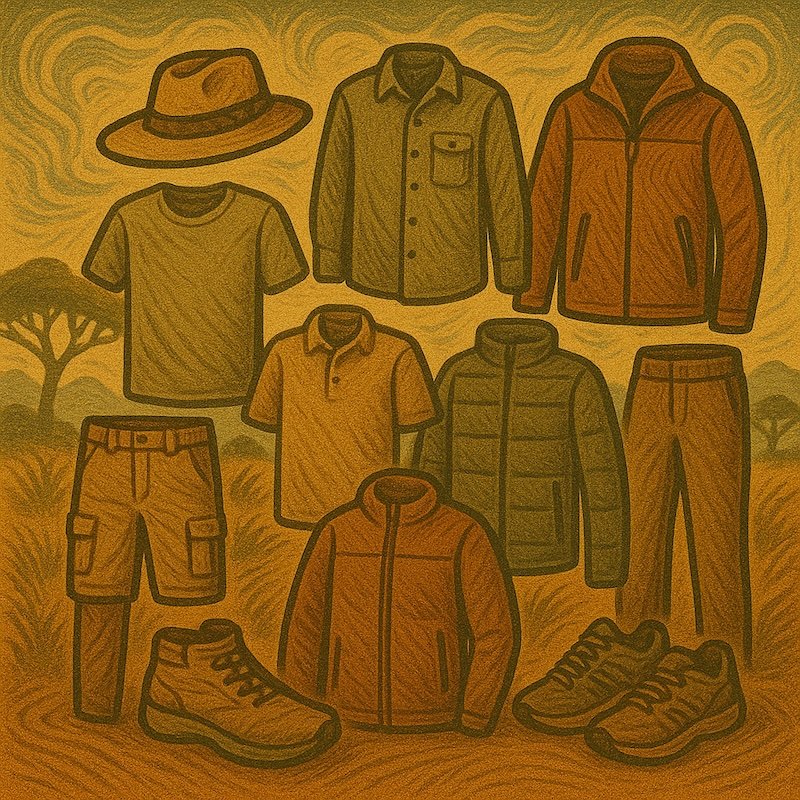
Build a 10-Piece Safari Capsule (Mix-and-Match for 7+ Outfits)
This keeps your bag light and your mornings easy:
- Long-sleeve UPF shirt (olive or stone)
- Breathable long-sleeve button-down (sage)
- Lightweight short-sleeve tee (khaki)
- Merino or poly base layer (for chilly dawns)
- Convertible pants (taupe)
- Soft stretch travel pants/leggings (earth tone)
- Packable fleece or insulated mid-layer
- Windproof/water-resistant shell
- Sneakers or trail shoes with grip
- Wide-brim hat (crushable)
Outfit ideas:
- Dawn drive: base layer + UPF shirt + fleece + shell + convertible pants + socks + hat + scarf/buff
- Late morning: strip to UPF shirt + pants (zip off if it’s roasting)
- Lunch in camp: tee + stretch pants + slides/flip flops
- Sunset drive: long-sleeve button-down + convertible pants (legs on) + light scarf
Add a scarf, swap tees, and you’ve got a week’s worth of combos without repeating the exact look.
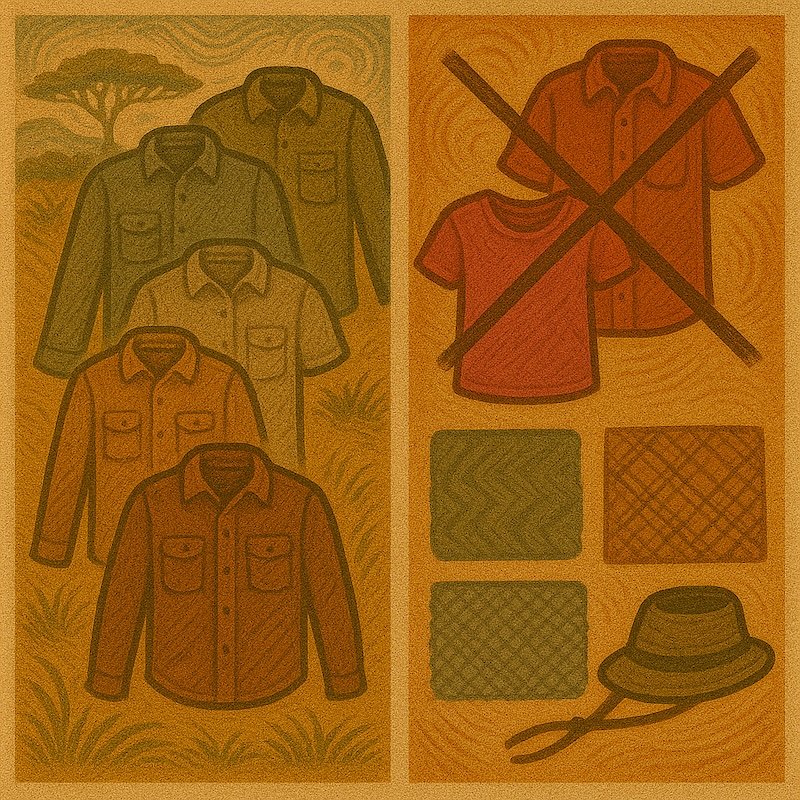
Color & Fabric Guide (Why It Matters)
- Colors that blend: olive, tan, stone, brown, muted gray, dusty green. These don’t distract wildlife or every other set of binoculars in the vehicle.
- Skip: bright red/orange/pink (look awesome in cities, not in the bush), stark white (dust magnet), and deep navy/black in tsetse zones. Camouflage prints are illegal for civilians in some countries—avoid to be safe.
- Fabrics that behave:
- Merino wool: naturally odor-resistant, warm when damp, soft—great base layers.
- Poly blends/nylon: light, quick-dry, good for shirts and pants.
- Stretch cotton or cotton-blend: comfy in vehicles, but slower to dry—fine if you’re not hand-washing nightly.
- Avoid noisy swishy fabrics: they can be annoying in a quiet vehicle.
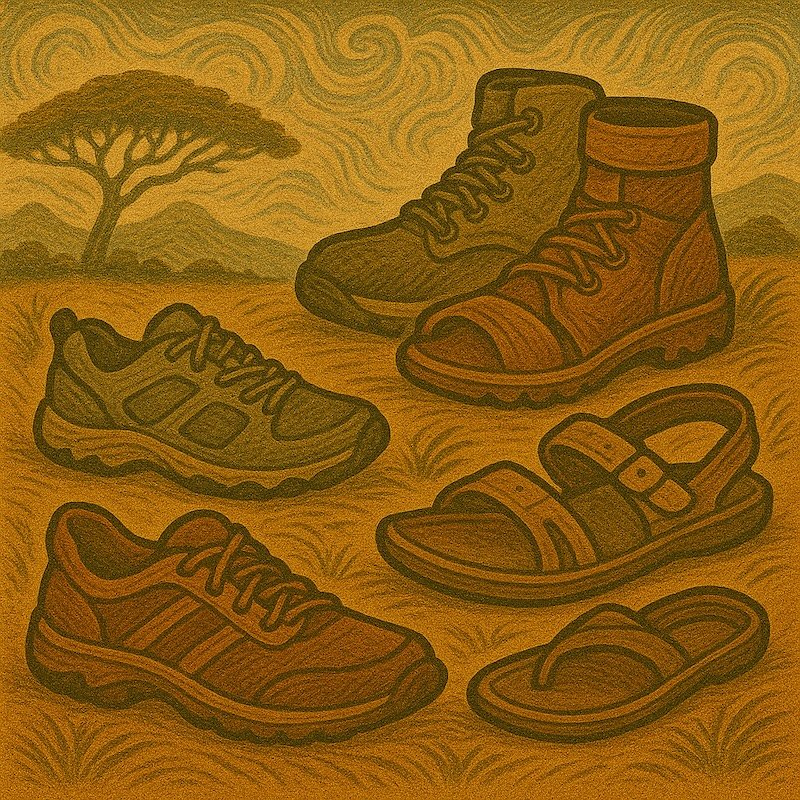
Footwear Deep-Dive: What Actually Works
| Footwear | Pros | Cons | Best For |
|---|---|---|---|
| Lightweight trail shoes / sneakers | Grippy, breathable, comfy all day | Not ideal when soaked; minimal ankle support | Game drives, short lodge walks |
| Low-cut hiking shoes | More support, sturdier sole | Heavier, hotter | Bush walks, rockier terrain |
| Hiking boots (mid) | Ankle support | Overkill for most lodge drives; bulk | Multi-day walking safaris |
| Closed-toe sandals | Cool, easy on/off | Dusty feet, less protection | Around camp, beachy add-ons |
| Flip flops | Shower/camp only | Zero protection | Pool/shower/run to the boma |
If you’re not doing full-day hikes, a single pair of grippy trail shoes + light camp sandals covers 99% of safaris.
Accessories That Earn Their Space
Sun & Wind Helpers
- Buff/neck gaiter: dust filter on drives; ear/neck warmer at dawn.
- Sunglasses with good coverage: polarized helps spot animals in glare.
- Hat retention: add a chin cord or clip; wind is relentless in open vehicles.
Tiny Comforts
- Thin liner gloves: surprisingly useful on frosty mornings.
- Hand sanitizer & baby wipes: quick “bush shower” between drives.
- Mini dry bag or zip pouches: dust proof your phone, passport, and memory cards.
Practical Tech
- Headlamp: better than a phone torch if walking to dinner in darker camps.
- Portable power bank: for phones and cameras on long drives.
- Soft earplugs: lodges can be lively at night (hyenas and snorers).
What Not to Wear (And Why)
- Camo prints: illegal for civilians in several African countries. Don’t risk awkward conversations at checkpoints.
- Bright whites: turn beige within minutes and reflect light like a signal mirror.
- Heels or hard-soled city shoes: vehicles = steps + ladders + uneven ground.
- Strong perfume/scented lotions: bugs love it; animals don’t.
- Fussy outfits: short skirts in open vehicles (breezy!), fragile fabrics (snags), jangly jewelry (noise + glare).
Special Safari Situations (Dress Codes That Surprise People)
Bush Walks (Guided on Foot)
- Long pants, long sleeves, very quiet shoes, hat. Leave bright colors and dangling straps at camp. Follow your guide’s rules to the letter.
Night Drives
- Same as dawn: add fleece, wind shell, and maybe a beanie. A red-light headlamp preserves night vision if allowed.
Mokoro / Boat Safaris
- Quick-dry pants/shorts, long-sleeve UPF shirt, hat with strap, secure sandals or barefoot if told. Pack a light rain shell for spray.
Fancy Lodge Dinners
- No need to pack a whole “evening wear” capsule. A clean neutral tee or blouse + scarf + your least dusty pants or a simple midi dress with a light cardigan works everywhere I’ve stayed.
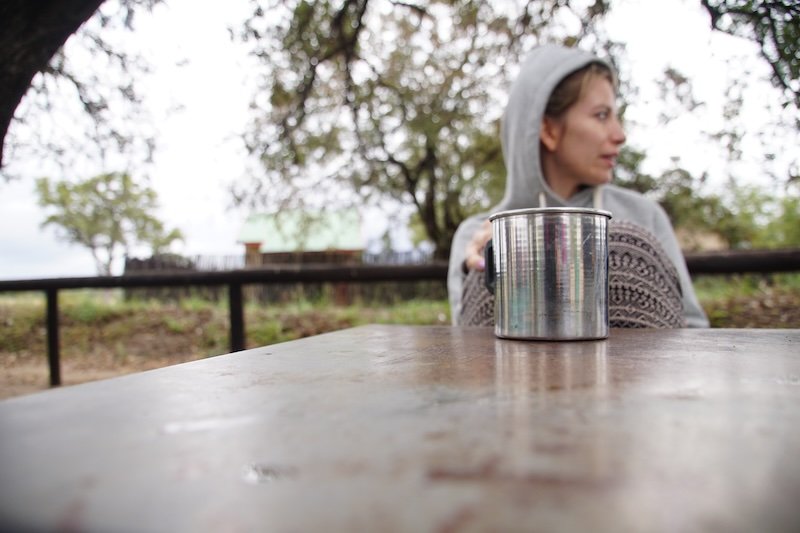
Laundry & Re-Wear Strategy (Travel Light Without Smelling Like a Lion)
- Re-wear smart: rotate two long-sleeves + one tee; hang items to air between drives. Merino base layers can go multiple wears.
- Hand-wash routine: a ping-pong ball size of soap in a sink; wring in a towel burrito; hang near a fan.
- Hotel/lodge laundry: many offer fast turnaround. Avoid sending delicates with special care labels.
- Anti-odour tricks: travel-size spray (vodka + water works too), baking soda sprinkle overnight (shake out next morning).
Sample Packing Lists You Can Copy
3-Day Lodge Safari (Carry-On Only)
- Tops: 2 long-sleeve UPF shirts, 1 neutral tee, 1 lightweight sweater/fleece
- Bottoms: 1 convertible pant, 1 stretch pant/legging
- Outerwear: light wind shell
- Sleepwear: 1 set
- Shoes: trail shoes + flip flops
- Accessories: hat, buff, light scarf, liner gloves, sunglasses
- Toiletries: sunscreen, lip balm SPF, moisturizer, basic makeup, deodorant, meds
- Tech: phone, charger, power bank, headlamp
- Extras: refillable bottle, snacks, small first-aid kit
7-Day Overland (Mixed Camps & Lodges)
- Tops: 3 long-sleeve shirts (incl. 1 merino base), 2 tees
- Bottoms: 2 pants (1 convertible), 1 light short
- Outerwear: fleece + rain/wind shell
- Underthings: 5–6 undies (quick-dry), 2 sports bras, 4–5 socks (wool blend)
- Shoes: trail shoes + camp sandals
- Accessories: hat, buff, scarf, beanie, gloves
- Sleep: warm layers (nights can dip)
- Laundry kit: travel soap, elastic clothesline, a few pegs
- Tech/other: above + binoculars if you’re a keen spotter
Photographer’s Add-Ons (Only If You’ll Use Them)
- Beanbag or small pillow (steadies lenses on vehicle rails)
- Microfiber cloths + rocket blower (dust patrol)
- Spare batteries + memory cards in a zip pouch
- Cross-body camera strap (more stable in vehicles)
Quick Comparison: What to Emphasize Where
| Region | Season | Dawn Temp | Midday Temp | Clothing Focus |
|---|---|---|---|---|
| Kruger (SA) | Winter (Jun–Aug) | 0–6°C | 18–25°C | Warm base, fleece, wind shell; pants; beanie/gloves |
| Kruger (SA) | Summer (Nov–Mar) | 18–23°C | 28–35°C | UPF longsleeves, airy pants/shorts, hat, light rain shell |
| Serengeti/Mara (TZ/KE) | Dry (Jun–Oct) | 8–12°C | 22–28°C | Layers for cool mornings at elevation; dust protection |
| Serengeti/Mara (TZ/KE) | Green (Nov–Dec & Mar–May) | 14–18°C | 24–30°C | Quick-dry fabrics, light rain shell; anti-chafe shorts |
| Namib Desert (NA) | Year-round | 5–12°C | 20–32°C+ | Windproof layer, neck gaiter, strong sun protection |
(Temps are typical ranges—always check your dates!)
Mini Checklists You’ll Actually Use
Game-Drive Caddy (Pack This in Your Day Bag)
- Phone/camera + spare battery
- Sunglasses + microfiber cloth
- Buff + light scarf
- Lip balm SPF + sunscreen stick
- Water bottle + a snack (bites in between sightings are essential)
- Tissues and hand sanitizer
- Lightweight gloves (winter)
- Small cash tip for your tracker/guide (if applicable)
Camp Shower Kit
- Quick-dry towel (if not provided)
- Conditioner (the sun + dust combo is ruthless on hair)
- After-sun lotion or aloe gel
- Insect repellent (if you’ll be out at dusk)
Vehicle Essentials (Group Wins)
- Trash bag for the back row
- Wet wipes pack
- Tiny first-aid (plasters, ibuprofen, antihistamine)
- Zip bags for dust-proofing electronics
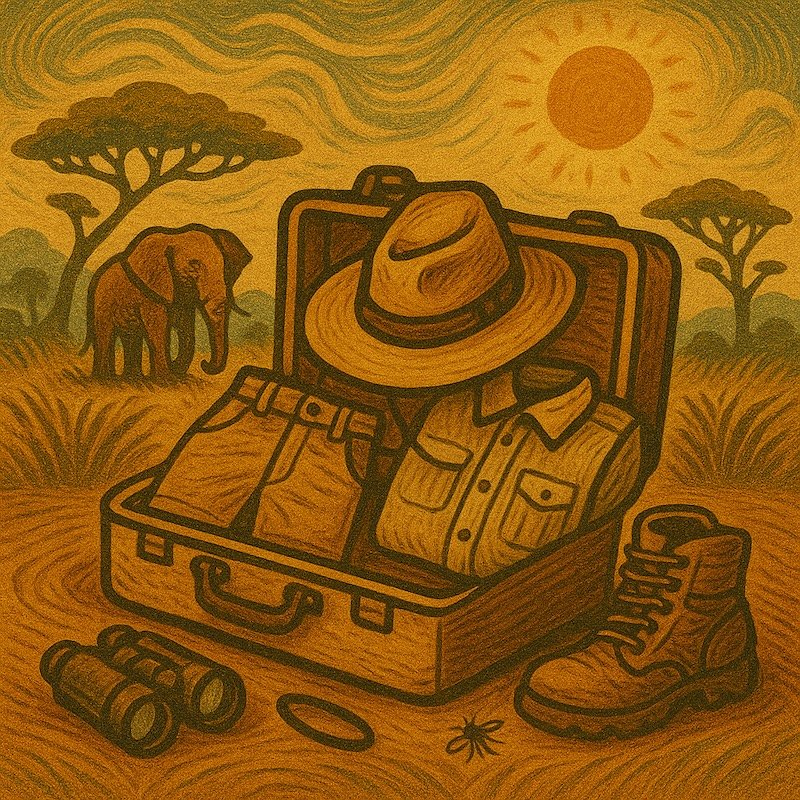
Safari Packing Trip FAQ
Do I have to wear neutrals, or is that just a “look”?
You don’t need to cosplay as an extra from Out of Africa, but muted, earthy colors genuinely help: they keep you cooler, show less dust, and are less distracting for both wildlife and other guests who are scanning the bush. Save the brights for city days before/after.
Are camouflage prints okay on safari?
Skip them. Camouflage is illegal for civilians in several African countries, and wearing it can invite awkward attention at checkpoints. Solid neutrals are the safer (and easier to pair) option.
Will regular sneakers be enough or do I need hiking boots?
For classic lodge game drives and short guided walks, grippy sneakers or low-cut hiking shoes are perfect. Boots make sense only if you’ve booked multi-hour walking safaris or very uneven terrain. Most guests never need heavy boots.
How cold is “cold” on a dawn drive?
Cold enough that you’ll be grateful for a base layer, fleece, wind shell, and a blanket on your lap—especially in winter or at elevation. The wind chill in an open vehicle is real. Pack thin liner gloves and a beanie if you run cold.
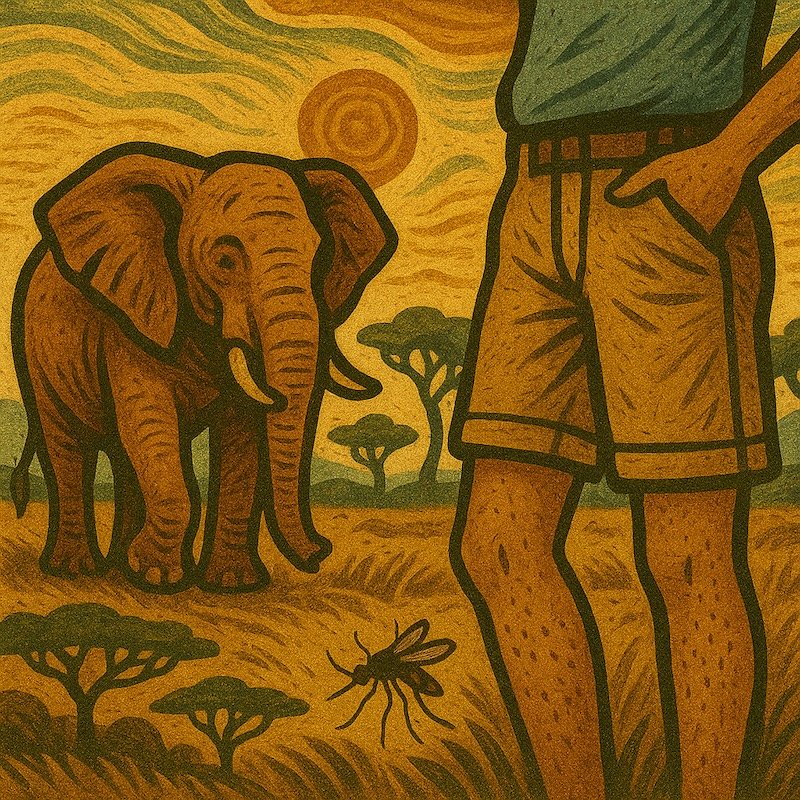
Can I wear shorts on safari?
Yes—mid-thigh to knee-length shorts are fine around camp and on drives in warmer months. For bush walks, many guides require long pants for protection. If bugs love you, long lightweight pants are more comfortable any time of year.
What do people wear to dinner at lodges?
Think relaxed smart-casual. A clean tee or blouse with your least-dusty pants, or a simple midi dress with a cardigan. Closed shoes are nice on sandy paths at night. No one expects glam; comfort is king after a long day outdoors.
How many outfits do I need for a week?
You can do a full week with a 10-piece capsule: three tops (two long-sleeves + one tee), two pants (one convertible), one base layer, fleece, shell, trail shoes, and a hat—plus underwear/socks. Plan to re-wear and do a quick sink wash once or twice.
Is black really a problem?
In classic Kruger lodges—no. In some tsetse fly areas (parts of East/Central Africa), dark blue/black can attract them more readily. If your itinerary includes known tsetse zones, lean into lighter earth tones and avoid deep navy/black for day drives.
Do I need insect-repellent clothing?
Not mandatory, but treated items (or a DIY permethrin spray at home) can be helpful in buggy seasons. Otherwise, long sleeves, long pants, and regular repellent do the trick. Always follow label instructions.
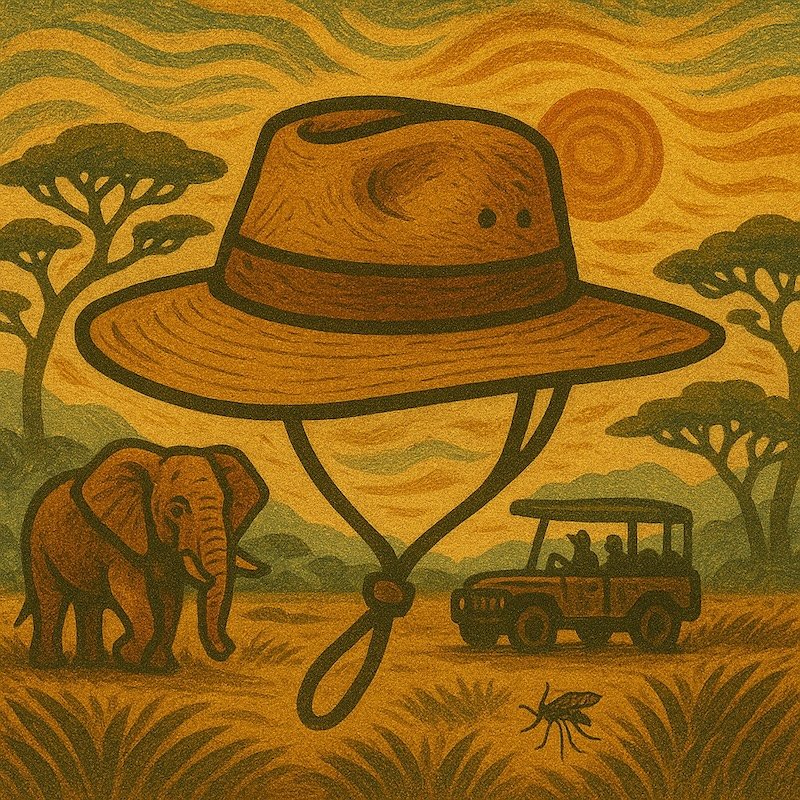
What’s the best hat style?
A crushable wide-brim (7–10 cm brim) that shades your ears and neck, ideally with a chin strap. Baseball caps are better than nothing but leave your neck exposed and blow off easily in open vehicles.
How do I keep dust out of my gear?
Use a buff over your nose/mouth on dusty tracks, stash cameras/phones in zip pouches between sightings, and carry microfiber cloths. Back at camp, a quick wipe of lenses/screens and a shake-out of your bag helps a lot.
Any “don’t pack it” items you see people regret?
Hard yes: high heels, bulky fashion handbags, heavy jeans that never dry, white outfits, strong perfume, jangly jewelry, and drones (often prohibited in parks). If it’s high-maintenance at home, it’ll be twice as fussy in the bush.
Do you have any other suggestions of what to wear on safari?

Thanks for sharing. I guess almost everything is on the list, no need to suggest.
Did you wear black leggings? Just curious since you said they attract flies. All my leggings are pretty much black or dark blue!
Hi Mary, tse tse flies weren’t an issue where I was travelling, so dark leggings were not a big consideration for me. However, if you’re doing your safari somewhere in mid-continental Africa, then you’ll want to think about the colours you take.
I packed a grey ultralight down jacket for a September safari in Kenya. It really came in handy. Sleeping in a luxury tent camp is just as chilly as a regular tent! I used my jacket as an extra layer at night. I was very glad to wear it for my 4:30 am hot air balloon ride and the 6 am game drives. The days warm up quickly, but the early mornings can be quite cool. The jacket fit easily into my day bag and kept me comfortable. Remember that open top safari cars get a lot of sun, and the seats get hot. Choose knee-length skirts and shorts shorts or capris for comfort as well as cultural sensitivity. Grey is a good color for safari, and looks nice for the stopover cities in Europe. I packed a silk dress for dinner and a maxi skirt for visiting villages. I received many compliments wearing a long skirt in Kenya. My favorite pieces were my Macabi skirt, Mountain Hardwear skirt, and down jacket.
Your green utility jacket looks cute and functional. Where is it from?
That’s been in my closet for aaaages! I believe it was from Bluenotes.
On my recent safari to Tanzania, I brought all of the neutral colors, however, I wish I brought some of my other tops in different colors for dinners and when not on game drives.
Thank you for the list, it’s a very helpful overview while preparing for a safari!
Hi, I’m from South Africa and I do agree with some of these but wearing neutral colours it not the most important thing. I wouldn’t wear the brightest colours but generally people don’t care what you wear. Just wear anything comfortable because in my opinion that is the most important thing. Just another tip if you are going in the morning or in the evening but on layers because it starts of cold and then gets very hot in the morning (on night drives bring layers with as it will get cold in Summer or Winter).